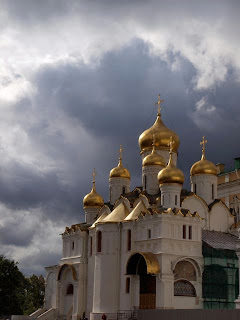
Twenty four hours on the train later, we arrived into Moscow's Kazansky station, and immediately dove into the morning rush-hour crowds that packed the metro. Moscow's metro is unlike any other subway system in the world. For starters, it's one of the deepest systems in the world, with some stations over 150 feet underground, and every ride begins with a 3 minute escalator descent down to the platform. Trains come every 60 seconds, but even that isn't enough to adequately cull the crowds that jam the system day and night. And for a subway dork like me, riding on original 1950 model Soviet stock is a huge thrill.
 A 1950s era subway car, still in use in Moscow.
A 1950s era subway car, still in use in Moscow.But the most unique aspect of the Moscow Metro is its sheer beauty. Every station is a work of art that tell a story or celebrates an event with stained glass, bronze sculptures, faience tiles, mosaics, and painting. Of course, the subjects of the artwork is closely tied in with the era in which the subway system was built- the 1930s, when Communism and Stalinism were in full swing. Changing lines, it's not uncommon to pass a bust of Stalin, a mosaic depicting a particularly moving speech by Lenin (complete with throngs of cheering proletariats), stained glass memorializing a WWII battle, and hammer and sickle plasterwork below a coffered vaulted ceiling. In the metro, it's hard not to feel like you're in a bit of a time warp, like by going underground you've entered a time warp where the the Soviet Union still exists.



Much like the metro system, the rest of Moscow lives in an uneasy space between its Communist past and its capitalist present. Flocks of tourists line up to enter Lenin's mausoleum, which sits directly across from the Louis Vuitton and Cartier stores that are the new tenants in the former Soviet state department store. Multinational banks occupy buildings that still have the decidedly anti-capitalist hammer and sickle symbol carved into their sides. A 24-hour McDonald's is in eyesight of the Red Square, where Soviet military parades used to file across. And when you're at the market, don't forget to buy your Lenin coffeemug or Stalin matryoshka doll.
 Protest like it's 1979: Communist demonstration in Yekaterinburg
Protest like it's 1979: Communist demonstration in Yekaterinburg.
Despite the myriad of signs of it's Communist past, Moscow is firmly rooted in the capitalist, money-grubbing world. For starters, it's EXPENSIVE. A Big Mac meal at McDonald's (at which we ate for research purposes, of course) costs $7; computers are marked up 50% from US prices; even a burger and coke dinner at an "American-style" diner set us back $15 a person. Luckily for us, Russia's fast food options are tasty and cheap; if it wasn't for those, we would have gone broke. How any Russian (average salary: $750 a month) affords anything is beyond me.
(Runaway capitalism might have also played a part in the other most frustration aspect of our time in Moscow: the closures of nearly every restaurant recommended in our guidebook. Nowhere else I've been has a year-old guidebook been so hopelessly out of date.)
Even though Moscow had it's share of frustration, there are so many interesting things to see there that it's hard not to have a good time. Lenin's body and mausoleum was as bizarre as we'd expected; St. Basil's cathedral is even more mesmerizing in person than it is in pictures; the Gulag (Soviet forced labor camp) museum was sobering; and the vodka museum was intoxicating. Not even the closures and four days of cold and rain could dampen (or freeze) our spirits- Moscow's a city that deserves to be seen for itself.
 The Kremlin
The Kremlin



